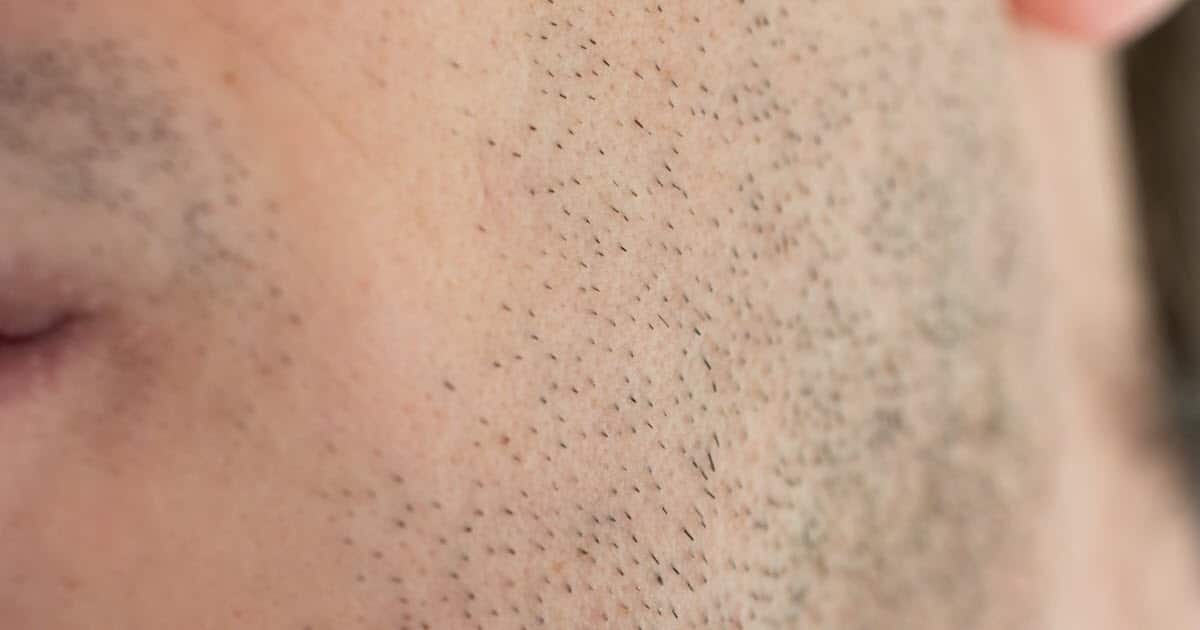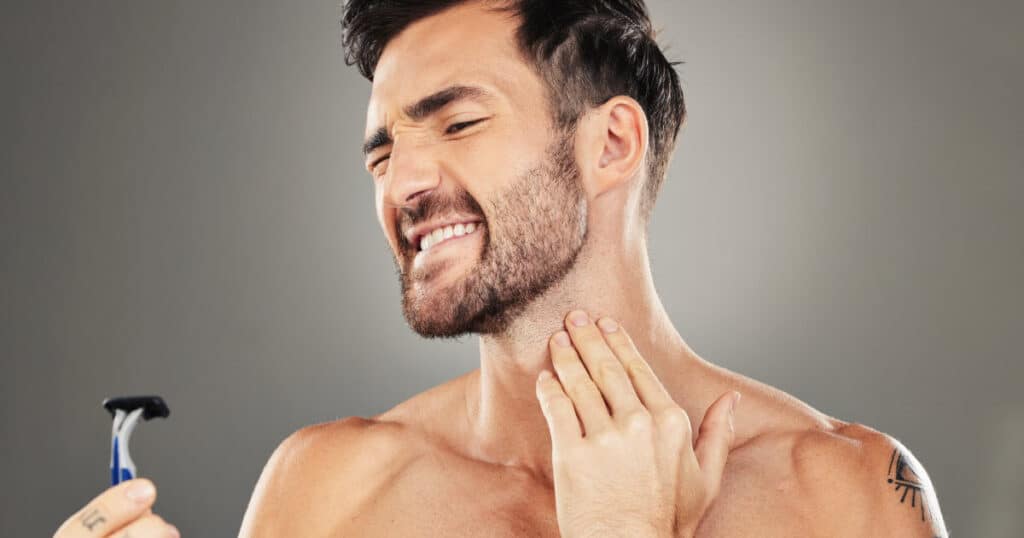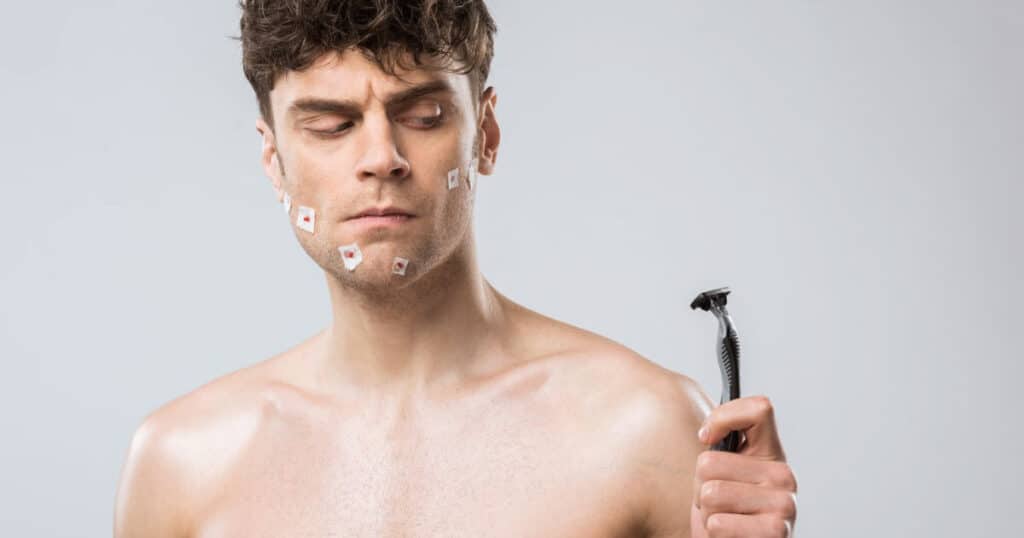We recently became obsessed with reruns of the old show Seinfeld, and there’s a great scene that tackles the question, “Does shaving make facial hair grow faster?” In it, Jerry “notices an asymmetry in his chest hair,” and “does something stupid”:
So is that true? Does shaving really make facial hair and body hair come in thicker and fuller and darker?
Let’s to the bottom of this.
No, It’s Doesn’t
If you’re just here for a yes/no, we won’t hold you up: no, shaving does not make your hair grow back thicker. There are ways to make your hair grow thicker, but shaving isn’t one of them. No matter how much your grandpa insists that shaving your face will result in a thick, rich beard, he’s wrong. It won’t.
According to an article by Dr. Howard Behrman written for the Journal of the American Medical Association, shaving has no effect of your body’s production of hair, whether on your face or your chest or anywhere else. When you shave, your hair does in fact grow back quickly immediately after your shave, but the rate slows dramatically after a few hours, and the end result is that your hair grows at the same rate it would had you left it alone.
That’s good news for Jerry and Kramer in the scene above—it looks like Kramer’s horrifying chest hair actually was a result of genetics—but it’s bad news if you’re shaving a lot because you want to grow hair (and if you want to grow thicker facial hair or body hair, we’ll talk about your options in a minute).

The Science of It
Researchers created a very clever experiment to determine whether shaving body hair would make it grow back thicker and fuller: they had a group of mature, body-hair-having men shave one of their legs, while leaving the other un-shaven, and then after the hair grew back on the shaved leg, they compared thickness, volume, etc. between the two legs. After doing this a couple times, the researchers found no different between the hair that grew back on the shaven legs and the hair that was left alone.
So, inspired by the leg-shaving study, we at Rough and Tumble Gentleman did our own experiment in-house, and asked four friends of ours—all of whom are balding very early in life—to shave their heads for three weeks. Three were already regular head-shavers, and the fourth was reluctant, but eventually joined our study (thanks, Dan!).
After three weeks of observations, we reached three conclusions:
1) None of our balding friends grew any more hair than usual. In other words, the areas of their heads that were bald before shaving remained bald after shaving;
2) In areas that had hair, the hair that was shaved off didn’t grow back any thicker or any thinner than it had been before it was shaved (at least as per visual review); and finally
3) One participant actually thought his hair had grown thinner over the course of the experiment, although all the other participants disagreed.
As for the “pics or it didn’t happen!” crowd—unfortunately, none of our subjects agreed to be photographed. Thanks a lot, DAN.
But what about for guys who DO grow facial hair? Instead of bald guys who can’t grow hair on their heads, what about guys who CAN grow facial hair, but it’s light and wispy?
We did an experiment for that, too. We asked two friends with “light whiskering” to double the regularity with which they shaved. Both shaved three times a week; we asked them to shave seven days a week, and share the results after two weeks. The results: no results. After two weeks, the hair on their face was coming at regular speed, and with the expected thickness. They did, however, get some razor burn (and we’ll talk about that below).
The reason their whiskers didn’t grow back more fully is based on long-established science:
Hair growth originates in the dermis, located beneath the skin. The dermis houses hair follicles, which are based at the hair root. Here’s a basic diagram:

Image Credit: OpenStax College
The number of hair follicles on your skin is determined by your family lineage and genes, your age, and your hormones, and that number of hair follicles is a pretty good indicator of how thick your facial hair will be. Men with a high number of follicles will have more whiskers on their faces, and men with a lower number of hair follicles on their faces will have fewer whiskers on their faces. Shaving will not, under any circumstances, increase the number of hair follicles you have in your dermis, so it won’t increase the number of whiskers that grow on your face.
That, combined with a study done by the Journal of Investigative Dermatology in 1970 that determined shaving does not increase the width or rate of growth for individual facial hairs, and shaving more often =/= thicker facial hair.
Where Did This Myth Come From?
So we’ve answered the questions, “Does shaving make facial hair grow faster,” and the answer is “no.” If that’s the case, where did people get this idea from?
We’ve found three different theories why this old wives’ tale occurred:
1) It Happens Elsewhere in Nature. If you have any experience with botany or gardening, you know that when you prune a plant, the plant will respond with new growth. In fact, lack of pruning can inhibit growth, and many plants grow more after pruning. It’s not unlikely that men who work with plants—and it’s only recently that most of us stopped working with plants in some capacity—saw how quickly fruit trees and grapevines blossomed after pruning, and thought to themselves, “Hmmm… the beard’s looking a little bit light lately…” and (incorrectly) made the connection.
2) Incorrect Understanding of Causality. Men for all time have assumed that more shaving = thicker facial hair, because the more you shave, the thicker and more voluminous your facial whiskers will become. But it’s not the shaving that’s increasing the amount / thickness of facial hair, it’s simply the natural changes in your body that happen over time. Time’s effect on your body is the change agent, not the shaving. As time passes and men get older, their bodies grow thicker facial hair, and more of it. Over that same period of time, they’re also shaving, so a lot of guys mistakenly assume that it’s the shaving that’s making their whiskers fuller. Not the case.
3) A Perception Mistake. Shaving actually creates the appearance of thicker hair, regardless of where it happens on the body. Hair tapers at its end, and when you cut the shaft of the hair at the root, you’re cutting the hair at its thickest part. When it grows back a little bit, you’re seeing the thick root, as opposed to the tapered, wispy end of it. The hair looks thicker, but that’s because you’re now only looking at the thickest part of it—the root.
So if those are the reasons the myth came about, why does the wives’ tale persist? It’s odd, because if body hair and facial hair did actually come back stronger every time we shaved, we’d look like gorillas. We’d be covered in thick, dense hair, that would eventually become unmanageable. It doesn’t quite make sense that so many people believe the myth.
We can only speculate about why the misconception exists, but it’s probably reason #2: we see body hair get thicker over time—especially in our late teens and early twenties—and incorrectly assume it’s because we’re shaving, when in fact, it’s just because we’re getting older. Then we go off and tell everybody, “My beard’s gotten a lot thicker over the last couple of years; it’s probably because I’ve been shaving more / using X product / etc.”
I Don’t Believe You and I’m Going to Increase the Frequency of My Shave
We’re not doctors or dermatologists or medical professionals of any kind, and this is NOT medical advice, but we think that’s a really bad idea. Increasing the number of times you shave in any given week won’t create a thicker set of whiskers, and in fact, can do great damage your skin. You’re looking at:
Razor Burn. No fun. Razor burn is usually caused by shaving with a blunt blade (and cheap blades get blunt right quick), and/or overdoing it. Shaving isn’t really a natural process, and it causes trauma to the skin. That’s why wet shavers use pre-shave oils and all-natural soaps and creams: shaving is rough on the skin, and the skin needs protecting. If you’re shaving more than you need to—if you’re scraping a razor over skin that doesn’t have much hair growing out of it—you’re putting your skin through unnecessary trauma, and the result is often the bumps and mild rash that occur with razor burn.
Ingrown Hairs. Excessive shaving can also result in ingrown hairs, which are also pretty painful. If you’re shaving too often—and especially if you’re shaving with a disposable razor—you may do damage to the sub-dermal root of a whisker. When that whisker starts to grow back, it doesn’t have a clear path to grow through the outer layer of the skin, and the hair grows into the skin. The result is a red, painful bump, and if you’ve ever experienced a face-ful of these, you know it’s no fun.
Cuts. When your skin is over-shaved, it becomes weaker and more vulnerable, and that makes it fertile grounds for nicks and cuts. Nicks and cuts may be a normal part of the process—certainly in the beginning, when you’re learning to shave—but they can be unavoidable if you’re over-shaving.
You do you, but seriously—over-shaving can be dangerous and painful and bad for your skin. Please avoid.
So How Can You Grow Your Facial Hair?
We’re going to be straight-up honest: if you want a thick brush of manly facial and you don’t have it, there are three things you can do. You can 1) do nothing; 2) wait; and/or 3) use a product like monoxodil.
Let’s go through each of your options.
1. Do Nothing. The biggest factor in whether you have thick facial hair is genetics, and if the men (and women) in your genetic line have thick body hair and facial hair, chances are, you will too. If they don’t have thick body hair and facial hair, chances are, you won’t either. That’s just the way it is.
Facial hair is a lot like height: you can create an atmosphere where you can promote growth (eat right, exercise, etc.), but ultimately, you’re going to grow as much as your genes say you’re going to grow. You can take care of your skin, shave regularly, and so on, but ultimately, we get what we get. So be at peace with your genetics—if your genes enable you to grow facial hair, cool. If not, that’s fine too.
THAT SAID, it is important to note that a *lot* of guys who would like to have thick facial hair and don’t currently have thick facial hair can play the odds, and…
2. Wait. This is a reasonable option, really. Just wait, and be patient. Most men can’t grow a full beard until their late 20s or early 30s, and most men DO end up able to grow facial hair. For MOST men, it’s just a matter of time.
Of course, there are plenty of guys—and you probably know a few—who seem to buck that rule, and they’re able to grow a thick, manly beard by the age of 18. These guys are in a very small majority of dudes. Most men can’t grow a beard until their early-to-mid-twenties, and that’s true for man all over the world.
It’s a shame, if you think about it—young guys (the ones who are usually most motivated show their masculinity and virility) and the least-able to grow facial hair. If that’s you, have no fear: the odds are very strong that if you wait around a little bit, you’ll be able to grow the mustache / beard / fu manchu that you’ve been yearning for.
In another way, though, it’s kind of nice: sit back, do nothing, and the problem will solve itself. If only most of life were like that.
Of course, there’s a third option:
3. Use Monoxodil. Honestly, we don’t know a thing about Monoxodil, or any products like it. There are guys out there who use it to enhance the growth of their facial hair, and there are a lot of guys who are very happy they did. But all it takes for us is to read that list of possible side-effects on the bottle (which, strangely, includes hair loss) and we think, “Pass.”
That said, the list of side effects isn’t that intimidating. There was nothing written about mood swings, and more importantly, nothing written about what we’ll call “dysfunction of the manly variety,” and those would be the two side effects we’d be most concerned about. So maybe it isn’t so bad.
But again—we don’t know anything about Monoxodil. If you’d like to try it, talk to your primary care physician or dermatologist before giving it a go.
Thank you, Jerry and Kramer
That’s it for our post that de-bunks the “hair growth” myth. Shaving DOES NOT make body hair or facial hair grow back thicker, so shave away if you’ve got a thicker beard and you’ve been holding back, of stop shaving, if you’ve been over-doing it in hopes of having a thicker beard.
Thanks for reading, and be good!
Michael Morris is the head writer here at Rough and Tumble Gentleman. He's got a ducktail beard and loves Brazilian jiu-jitsu. He's married to the woman of his dreams and lives in Brooklyn, NY.




